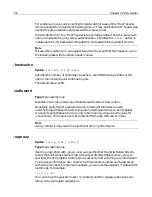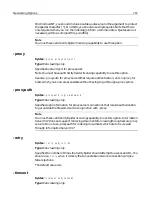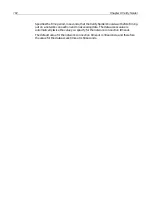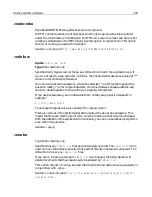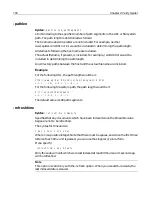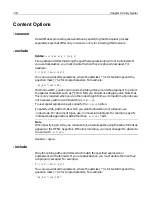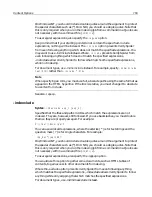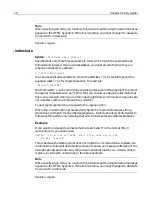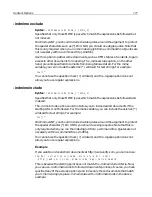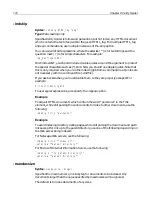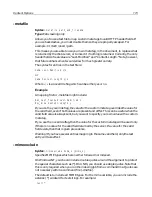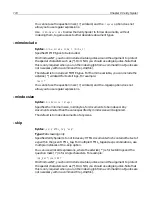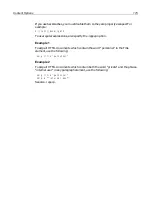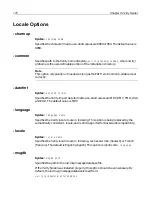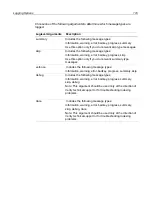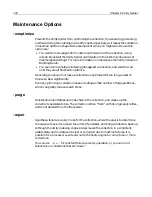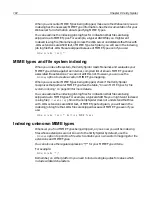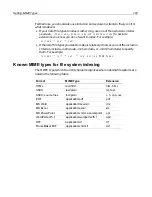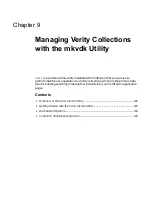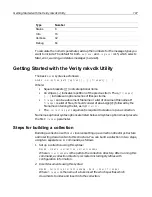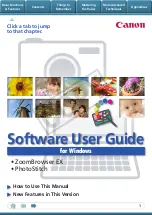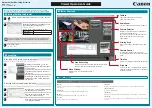
Content Options
173
-metafile
Syntax
:
-metafile path_and_filename
Type
: Web crawling only.
Allows you to use a text file to map custom meta tags to valid HTTP header fields. If
you use backslashes, you must double them so they are properly escaped. For
example: C:\\test\\docs\\path.
This means you are able to use your own meta tag, in the document, to replace what
is returned by the Web server, or to insert it if nothing is returned. Currently, the only
header fields of real value are "Last-Modified" and "Content-Length." Note, however,
that future enhancements could allow for much greater variety.
The syntax for entries in the text file is:
name Last-Modified y|n
or
name Content-Length y|n
Where
y|n
is an override flag which can be either yes or no.
Example
A mapping file for -metafile might include:
Doc_Last_Touched Last-Modified n
Doc_Size Content-Length y
If you use the y override flag, the value for the custom meta tag overrides the value for
the valid field, even if both values are present and differ. This can be useful when the
valid field value is always sent, but you want to specify your own value with a custom
meta tag.
If you use the n override flag, then the value for the custom meta tag will be used only
if there is no value for the valid field returned by the server. If a value for the valid
field exists, then that is given precedence.
Warning! If you have several entries mapping to the same valid field, only the last
entry will take effect.
-mimeexclude
Syntax
:
-mimeexclude mime_1 [mime_n] ...
Specifies MIME types which are neither followed nor indexed.
On Windows NT, you should include double quotes around the argument to protect
the special characters such as (*). On UNIX, you should use single quotes. Note that
this is only required when you run the indexing job from a command line. Quotes are
not necessary within a command file (-cmdfile).
The default is to include all MIME types. For the mime variable, you can include the
asterisk ( * ) wildcard for text strings. For example:
’text/*’
Summary of Contents for COLDFUSION 5-ADVANCED ADMINISTRATION
Page 1: ...Macromedia Incorporated Advanced ColdFusion Administration ColdFusion 5...
Page 20: ......
Page 56: ...38 Chapter 1 Advanced Data Source Management...
Page 74: ...56 Chapter 2 Administrator Tools...
Page 76: ......
Page 86: ...68 Chapter 3 ColdFusion Security...
Page 87: ...To Learn More About Security 69...
Page 88: ...70 Chapter 3 ColdFusion Security...
Page 130: ...112 Chapter 5 Configuring Advanced Security...
Page 132: ......
Page 154: ...136 Chapter 6 Configuring Verity K2 Server...
Page 162: ...144 Chapter 7 Indexing XML Documents...
Page 202: ...184 Chapter 8 Verity Spider...
Page 236: ...218 Chapter 10 Verity Troubleshooting Utilities...
Page 238: ......
Page 348: ...330 Chapter 14 ClusterCATS Utilities...
Page 349: ...Using sniff 331...
Page 350: ...332 Chapter 14 ClusterCATS Utilities...
Page 362: ...344 Chapter 15 Optimizing ClusterCATS...
Page 372: ...354 Index...


